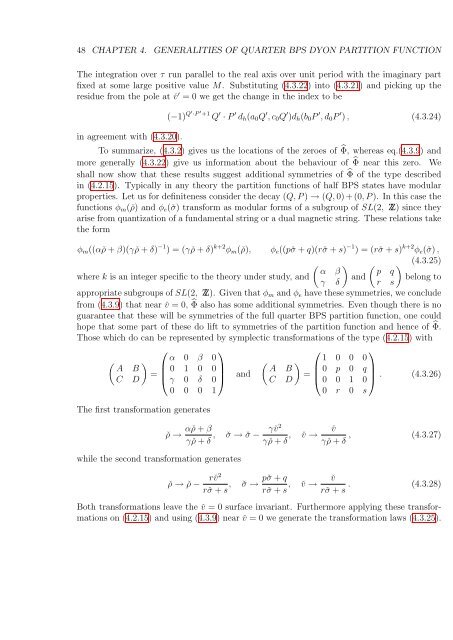PHYS08200604018 Shamik Banerjee - Homi Bhabha National ...
PHYS08200604018 Shamik Banerjee - Homi Bhabha National ...
PHYS08200604018 Shamik Banerjee - Homi Bhabha National ...
You also want an ePaper? Increase the reach of your titles
YUMPU automatically turns print PDFs into web optimized ePapers that Google loves.
48 CHAPTER 4. GENERALITIES OF QUARTER BPS DYON PARTITION FUNCTION<br />
The integration over τ run parallel to the real axis over unit period with the imaginary part<br />
fixed at some large positive value M. Substituting (4.3.22) into (4.3.21) and picking up the<br />
residue from the pole at ˇv ′ = 0 we get the change in the index to be<br />
in agreement with (4.3.20).<br />
(−1) Q′·P ′ +1 Q ′ · P ′ d h (a 0 Q ′ , c 0 Q ′ )d h (b 0 P ′ , d 0 P ′ ) , (4.3.24)<br />
To summarize, (4.3.2) gives us the locations of the zeroes of ̂Φ, whereas eq.(4.3.9) and<br />
more generally (4.3.22) give us information about the behaviour of ̂Φ near this zero. We<br />
shall now show that these results suggest additional symmetries of ̂Φ of the type described<br />
in (4.2.15). Typically in any theory the partition functions of half BPS states have modular<br />
properties. Let us for definiteness consider the decay (Q, P ) → (Q, 0) + (0, P ). In this case the<br />
functions φ m (ˇρ) and φ e (ˇσ) transform as modular forms of a subgroup of SL(2, Z) since they<br />
arise from quantization of a fundamental string or a dual magnetic string. These relations take<br />
the form<br />
φ m ((αˇρ + β)(γ ˇρ + δ) −1 ) = (γ ˇρ + δ) k+2 φ m (ˇρ), φ e ((pˇσ + q)(rˇσ + s) −1 ) = (rˇσ + s) k+2 φ e (ˇσ) ,<br />
( ) ( ) (4.3.25)<br />
α β p q<br />
where k is an integer specific to the theory under study, and and belong to<br />
γ δ r s<br />
appropriate subgroups of SL(2, Z). Given that φ m and φ e have these symmetries, we conclude<br />
from (4.3.9) that near ˇv = 0, ̂Φ also has some additional symmetries. Even though there is no<br />
guarantee that these will be symmetries of the full quarter BPS partition function, one could<br />
hope that some part of these do lift to symmetries of the partition function and hence of ̂Φ.<br />
Those which do can be represented by symplectic transformations of the type (4.2.15) with<br />
⎛<br />
⎞<br />
⎛<br />
⎞<br />
( )<br />
α 0 β 0<br />
( )<br />
1 0 0 0<br />
A B<br />
= ⎜ 0 1 0 0<br />
⎟ A B<br />
C D ⎝ γ 0 δ 0 ⎠ and = ⎜ 0 p 0 q<br />
⎟<br />
C D ⎝ 0 0 1 0 ⎠ . (4.3.26)<br />
0 0 0 1<br />
0 r 0 s<br />
The first transformation generates<br />
while the second transformation generates<br />
ˇρ → αˇρ + β<br />
γˇv2<br />
ˇv<br />
, ˇσ → ˇσ − , ˇv →<br />
γ ˇρ + δ γ ˇρ + δ γ ˇρ + δ , (4.3.27)<br />
ˇρ → ˇρ −<br />
rˇv2<br />
rˇσ + s ,<br />
pˇσ + q ˇv<br />
ˇσ → , ˇv →<br />
rˇσ + s rˇσ + s . (4.3.28)<br />
Both transformations leave the ˇv = 0 surface invariant. Furthermore applying these transformations<br />
on (4.2.15) and using (4.3.9) near ˇv = 0 we generate the transformation laws (4.3.25).

















